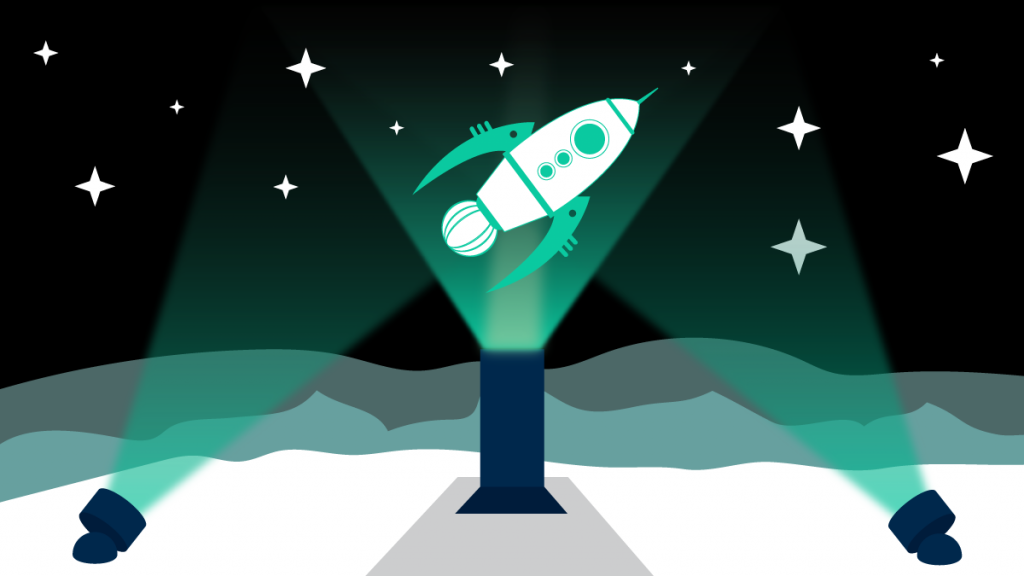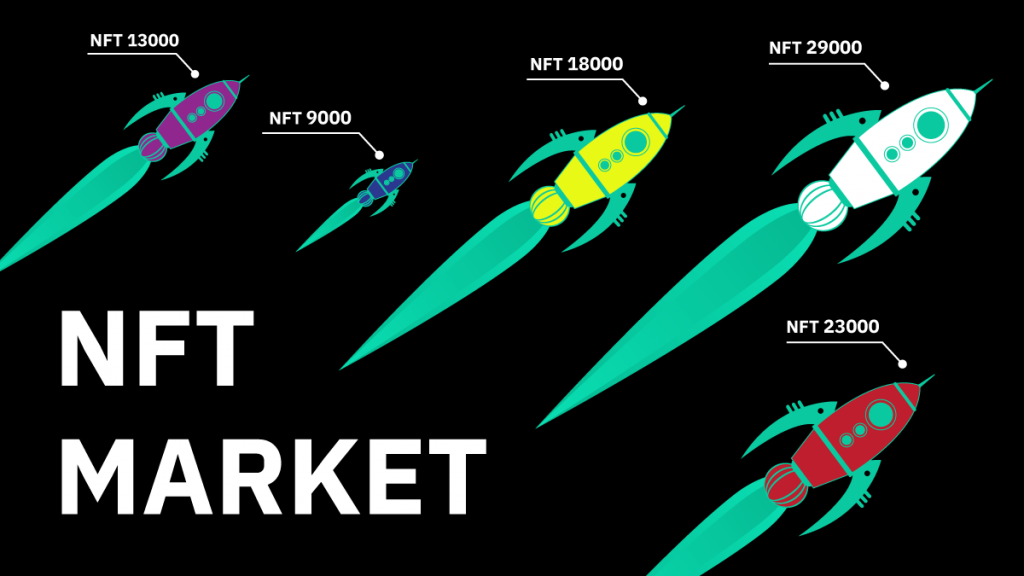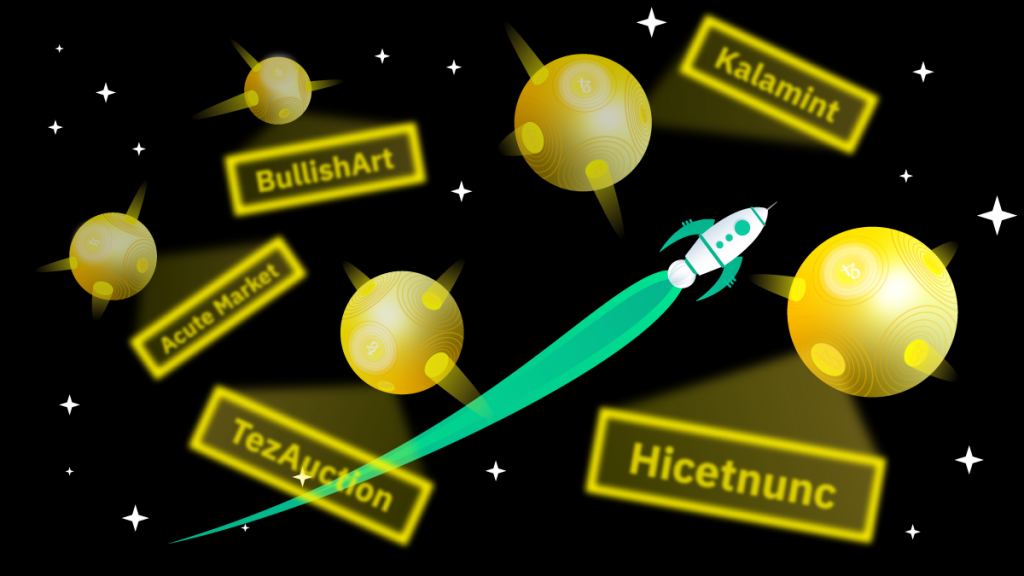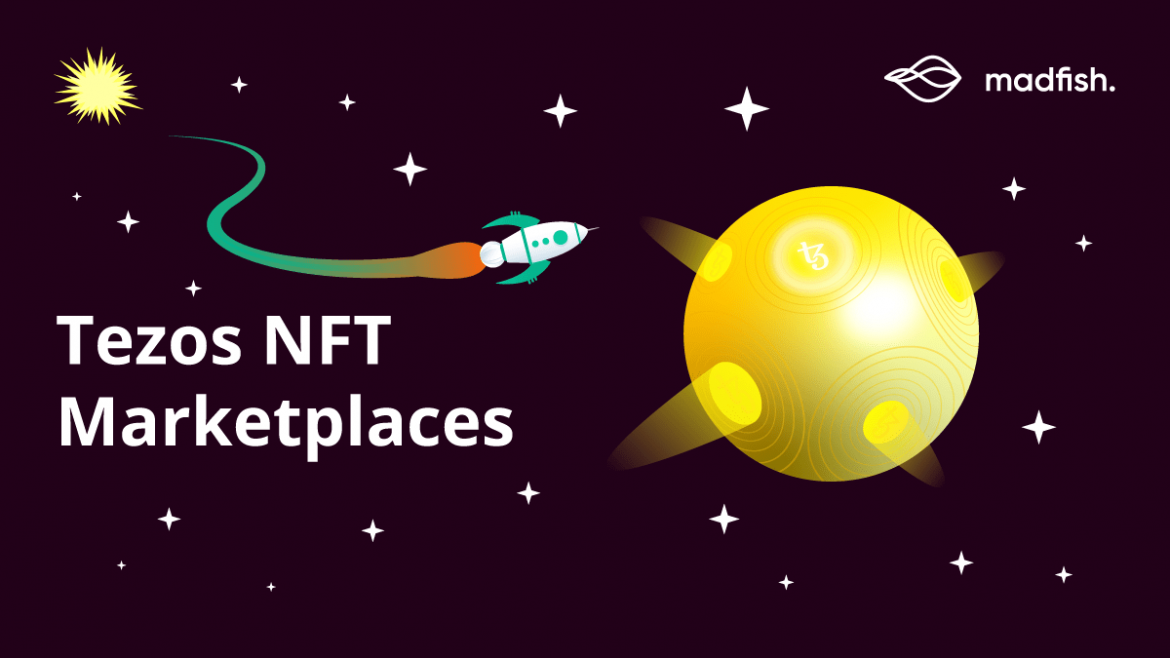It’s hard to miss the hype around NFTs, the unique blockchain-based tokens representing one-of-a-kind digital value. These days, they are booming: during 2020, the NFT market tripled and reached over $250 million, according to a NonFungible.com report. In 2021, the numbers are still impressive: the artist Beeple sold his collage Everyday: The First 5000 Days at Christie’s for $69 million in March 2021.
If you’re interested in trading unique digital assets, it’s high time to enter the market! All you need is to do is understand the NFT basics and find a reliable place to trade. We’re here to help you do both.

What are NFT tokens?
NFTs, or non-fungible tokens, are any cryptographic assets on the blockchain with unique identification data that guarantees each token’s rarity and will increase its value. NFTs have specific characteristics and limitations:
- Unique. Each token is one-of-the-kind.
- Cryptographic. NFTs work on blockchain technology.
- Not interchangeable. You can trade 1 XTZ for another 1 XTZ and get the same value. You can’t do the same with NFTs as each token is different.
- Verifiable. Anyone can check the authorship, ownership, and full description in the blockchain anytime.
The technology behind NFT
The virtual game CryptoKitties made NFTs popular in 2017. The project raised more than $40 million in six months and revealed several interesting things about NFT tokens.
Superficially, CryptoKitties appears to be a mix of Tamagotchi and Magic: The Gathering card game. You’re offered a set of cute digital kitties to buy, breed, and sell later. For this to happen, the game introduced a new technological standard to the blockchain ecosystem.
On Ethereum, the smart contracts use ERC-20, the basic set of rules that determines how transactions work. But the core concept of non-fungibility in NFTs called for the appearance of the ERC-721 standard. That’s how its list of novations made the game work:
1. Every token has unique identifiers. They serve as “genes” for kitties, creating a one-of-a-kind appearance for each.
2. Assets have a single wrapping contract. That’s how unique kitties were united in CryptoKitties class.
3. Smart contracts track ownership in a simple form. While pressing “Buy,” you become an owner of a kitty. You can only buy a whole kitty, not part of one.
4. When two tokens interact, they create a new unique one. That’s how two CryptoKitties can breed and create a new CryptoKitty in the game.
5. The standard is similar to ERC-20 in terms of token transfers. That makes it easy and understandable for developers and users to interact with the game.
ERC-721 is not the only technological standard for NFTs on Ethereum. The list also includes ERC-1155 (it has lower gas costs compared to ERC-721) and ERC-998 (which allows NFTs to own other NFTs). The technology still keeps developing together with the NFT market.
What can be NFT tokens?
You can turn anything into a non-fungible token: photos, videos, food, texts, memes, or even a tweet (as Jack Dorsey did). Here is a list of some of the most successful NFTs:
- “Crypto art.” Digital art is published directly onto a blockchain as an NFT. The NFT acts like a certificate to prove the digital artwork is genuine. Just like in the traditional art industry, you can enter an auction, exhibit your artwork in a gallery, or create an art collection. Significant amounts of money can be involved here: the musician Grimes sold her WarNymph digital art collection for around $6 million.
- Gaming-related collectibles. After CryptoKitties came many more NFT gaming options and now also includes virtual characters, in-game items (like guns and helmets), and prizes for special achievements now. One of the most lucrative was the sale of land on the Axie Infinity gaming platform in February 2021 for $1.5 million.
- Sport-related collectibles. The most popular blockchain-based sports platform is NBA Top Shot. It allows users to trade short videos from matches that feature top basketball players. According to the Dapper Labs platform executives, the gross sales have reached over $230 million by February 2021.

Who needs NFTs?
Artists. If you’re willing to show your creativity to the digital world, you can upload your creation as an NFT. You can list it on an online marketplace where platform visitors can buy it. A big advantage is that you can offer your NFT on a royalty-based model, getting paid every time your NFT changes hands; an income model not previously available when you traditionally sold art in its physical form.
Buyers. You are able to financially support artists directly and even become the first fan of a celebrity-in-the-making. When you purchase an NFT you own the rights to the original digital version, which will be recorded in the blockchain for anyone to see.
Collectors, traders, and investors. If you’re interested in creating a sort of online gallery, NFT tokens make it easier to find and manage artworks. You can buy NFTs, exhibit them together in a marketplace, and get the opportunity to sell each one for even more money.
How to create NFT tokens on Tezos?
To enter the NFT market as an artist, you need to mint (or upload) your artwork. In the Tezos blockchain, NFT tokens are created in the FA2 standard. The standard is universal: it is used for fungible and non-fungible tokens alike and allows not only minting but also managing and trading NFTs. The corresponding files are stored in the IPFS file-sharing system. This speeds up and facilitates the processes in the Tezos blockchain — you can mint automatically, upload quickly, and spend minimal money.
Main advantages of minting on Tezos:
1. Energy consumption. The Tezos blockchain is energy-efficient compared to Ethereum and Bitcoin. It relies on Proof-of-Stake instead of Proof-of-Work and thus, requires much less computer energy to work. In the case of heavy NFT tokens, this means reducing the carbon footprint to a minimum.
2. Cheaper cost. The Tezos blockchain has much lower transaction fees than Etherium. According to XTZ.news estimates, minting an NFT on Ethereum may cost you from $10 to $50, while Tezos platforms offer the same option for around $0.34.
3. Security. Tezos is one of the most reliable blockchains with a strong community that constantly tracks the superior security of transactions.
4. Marketplaces. Compared to most other blockchains, Tezos has established marketplaces to trade NFT tokens.
5. Decentralization. The Tezos blockchain is censorship-resistant. This means you have more control over your creations since the platform cannot be closed.
You can mint NFTs on an OpenMinter minting platform or on Tezos marketplaces Hicetnunc and Kalamint. The easiest and most secure NFT-compatible wallet is Temple Wallet. Alternatively, you can try Kukai, Spire, or Galleon.

Top marketplaces on Tezos
Thanks to its numerous advantages, the Tezos blockchain is gaining momentum. This year, the biggest NFT marketplace OpenSea is about to add Tezos to its platform and embeddable system. Before it happens, check these Tezos-based NFT marketplaces.
Objkt.com
Objkt.com is an excellent alternative to OpenSea on the Tezos blockchain. It’s a marketplace with many authors, large trading volumes, detailed statistics, and various collections. Objkt.com is a user-friendly NFT platform that collects the best NFTs from the most popular sites.
This is a first-of-its-kind marketplace on Tezos that allows users to construct and sell fully generative NFTs. Articts can use the toolkit to create NFTs with the help of programming code, set rarity parameters of each work’s elements and mint NFTs in the blockchain. The fxhach created the guide to provide artists with step-by-step instruction on how to launch a new generative token or collection using available tools. By June, 2022, fxhach is one of the most active NFT Marketplace on Tezos with more than $4,25 in monthly volume
Hicetnunc (Stopped)
One of the most recognizable and functional Tezos NFT marketplace at the time launched in February 2021. Rafael Lima, a Brazilian developer, designed it as the first energy-efficient NFT marketplace. Users had an opportunities to mint (OBJKT), swap, cancel (or mark as ‘Not for Sale’), and burn their NFT tokens on the platform. The wallet options include Temple Wallet, Kukai, Galleon, or Spire.
In November 2021, the marketplace stopped its work, but the community launched a mirror and is working on the marketplace clone with joint efforts. In addition, community created another few “forks” of the original marketplace, including Teia, third popular NFT marketplace on tezos by June 2022.
Kalamint
The marketplace launched in March 2021 as a decentralized gallery-curated market. On the platform, you can mint, sell, and collect NFT tokens. The main difference from Hicetnunc is the presence of a DAO-governed guild of experts who work as an authority to evaluate artists and prevent plagiarism. It uses the Temple Wallet browser extension for transactions.
TezAuction
The configurable auction-driven marketplace for NFTs that currently works in beta version. At the moment of writing, it has an established partnership and integration with Biconomy, which allows minting digital artworks and rare collectibles as NFT tokens for free. The platform supports listing and auctioning all the minted items.
Acute Market
The augmented reality marketplace will launch in summer 2021, currently in beta version. Designed by a London-based design studio, the platform will attract independent artists interested in AR, VR, and environmental sustainability.
BullishArt
The marketplace that grants BART tokens for minting NFTs on its platform. It works as a curated online art collection. Bullishart secures authentication and promotes contemporary artists through its channels.
ByteBlock
ByteBlock is a new marketplace for NFT creators on the Tezos blockchain. The platform supports the main wallets of the ecosystem, including Temple, Spire, Galleon, and Kukai. Several dozen artists have already published their works here.
Bazaar
Bazaar is an NFT market that supports creators, collectors, and crypto-enthusiasts by providing a user-friendly, carbon offset NFT market experience. The project has a governance token, bDAO, which allows holders to influence the project, participate in a yield farming program on the Crunchy.network, and provide liquidity on QuipuSwap.
MinterPop
MinterPop is an NFT art and collectibles marketplace on the Tezos blockchain, which appeals to fans of comics and pop art. The InterPop development team is focused on building an ecosystem of NFT comics and games on Tezos.
OneOf
This NFT marketplace on the Tezos blockchain was created for fans and music artists. The creators of OneOf are working to popularize NFT technology among the music community. That is why their platform is more like a classic service with the ability to buy music tracks and albums using cryptocurrencies or standard debit and credit cards.
Other NFT-related projects
Several interesting projects have also appeared on the market that will diversify NFT users’ experiences in the Tezos ecosystem. These range from virtual exhibitions to domain name generation. Let’s take a look at some of them below.
The platform for monitoring NFT collections on Tezos. Each collection has a description, circulation, and status: traded on the secondary market (Launched), traded on the primary (Live), and prepares for sale (Soon or TBA). A handy tool for researching a variety of NFT projects.
onCyber
onСyber is an original platform that allows anyone to arrange a real exhibition of NFT tokens in a virtual 3D space. The project supports several networks, including Tezos.
Mūrālis
Mūrālis is a unique project on Tezos. It is a mural of 10,000 squares, 10×10 pixels each. Anyone can add their NFT here, and it will remain in the blockchain forever. Once all the free pixels are filled, the whole NFT token will be sold on the marketplace, and half of the income will be distributed among the artists.
TzPunks
TzPunks, a project inspired by CryptoPunks, follows the same idea but is now on the Tezos blockchain. The maximum number of punks is limited to 10,000, and once they are minted, the marketplace will be launched. Users will be able to exchange and trade their Tezos-punks with each other.
Tezos Domains
Tezos Domains allows anyone to use friendly addresses’ names on Tezos, and create and purchase unique domains. Tezos names are FA2-compliant NFTs that you can own and control in your crypto wallet. Names can be bought and sold in an auction model.
Why start trading?: The future of NFTs
NFT tokens possess substantial value for all the participants of the art market. Artists can gain direct access to the public online, sell their creations, experiment with various digital tools, and enjoy the transparent royalty system. Buyers can protect their investment by possessing transparent and secure ownership over the artworks purchased and enjoy trading opportunities. For gaming and sports industries, the platform is a creative space for trading collectibles.
The future of NFT tokens is promising and will include a broader list of applications. For example, they can serve as an authenticity verification method for real-life objects (such as Nike-established CryptoKicks or digital wine collecting from Yahyn and Skipstone Winery). Alternatively, there are ideas to put the technology as the protocol basis to make fractionalized NFTs from privately-owned investment tradeable and replace security token offering (STO). All these trends make NFTs one of the most promising crypto inventions offering numerous opportunities for creative minds and their admirers.

